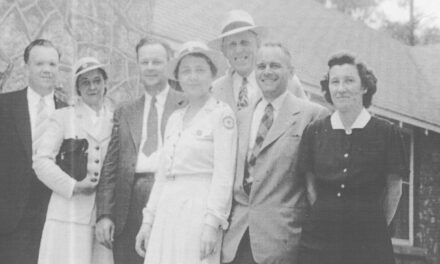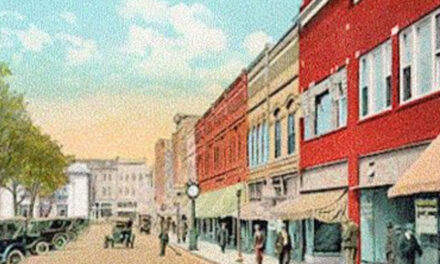
As the Allied invasion of France (D-Day) took place so did the invasion of polio in western NC. American troops took part in wresting the European continent back from the Nazis at the same time as local health professionals orchestrated a battle plan of their own, to fight infantile paralysis.
The local offensive began as a conversion. Nurse Frances Allen, Dr. Gaither Hawn, and Dr. H.C. Whims decided that a facility was needed to treat the rising number of patients stricken by the crippling and sometimes deadly disease. Taking a ‘fresh air’ camp built during the Great Depression, they retooled the building as an emergency hospital. On Thursday, June 22 work began. By Saturday afternoon, the first patient was admitted, a 54 hour transformation.

The 1944 hospital campus.
According to news of the time, the call for volunteers was heeded by people who came to work, taking on whatever task was needed. Tents furnished by the Army Corps of Engineers were set up, a local construction company brought in building materials and bulldozers to level the ground. It was a fantastic outpouring of concern by local residents. Collectively, they toiled through the day and night, never letting up until the emergency hospital was functional.
The response was called “miraculous,” especially since the National Foundation folks didn’t even know where Hickory was, much less what level of support folks in this part of the world might offer. Surprised by heartened, they partnered to man a center for anyone who might be suffering from polio, no questions asked.
During that summer, concern mounted to the point that children were banned from going to the movies, or even Sunday School. Balls Creek Camp Meeting was cancelled that year out of worry over the spread of polio. That has only happened one time since, rather recently.

Dr. Dorothy Horstmann attending a child suspected to have polio. The Hickory Emergency Hospital treated 454.
Not everyone got with the program. As epidemiologists tried to examine the conditions of households where children had gotten sick, some refused the doctor’s entrance. One even threw rocks to keep Dr. Dorothy Horstmann from coming in the house for fear of her spreading the disease she was there to treat. While not a stellar moment, it explains a lot about how terrified folks were.
Horstmann, as well as all the other medical professionals persevered. So did less scared members of the community, who managed to supply whatever the hospital needed to keep it going. It was a very communal effort. And a good story.
Life Magazine came down and photographed activity for a spread. The National Foundation filmed activity for a documentary they were preparing to raise funds for organization. The title of their presentation: The Miracle of Hickory.
t was a perfect example of what was possible, showing people working together for common cause. It happened 80 years ago this summer.









